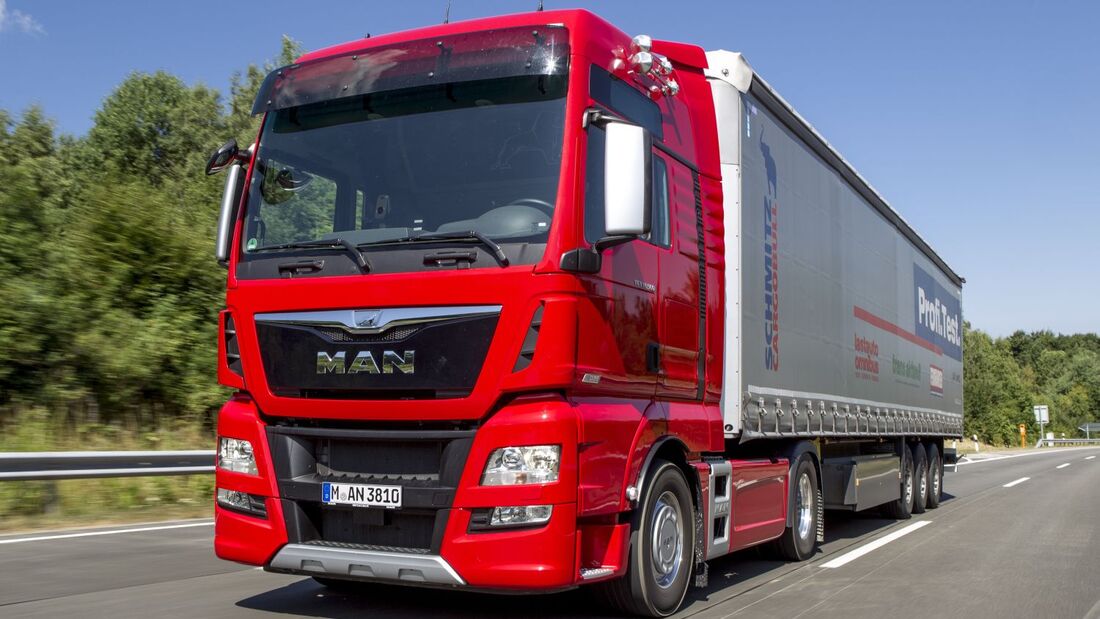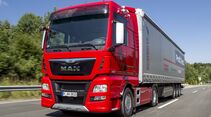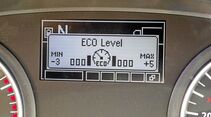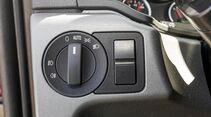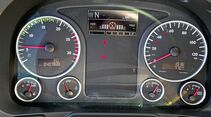It's an imposing sight. At over 1,500 rpm in tenth gear, the TGX 18.560 drags its 40-ton weight up the five percent incline at almost 70 km/h. As it accelerates out of the incline to 1,700 rpm, it quickly shifts through eleventh and twelfth gears and reaches its cruising speed before the measuring point signals the end of the hill measurement. Few 40-ton vehicles can so dynamically master this ten-kilometer incline of the A 1 autobahn near Trier in western Germany.
D38 too big for the TGS driver's cab
The father of this dynamism is a new six-cylinder engine called the D38. With a displacement of 15.2 liters and a long-stroke design (170 millimeters), it has been available since the end of last year in the TGX in three power classes of 520, 560 and 640 hp, with the most powerful variant reserved for heavy-duty tractors. The space beneath the more compact TGS driver's cab is obviously not sufficient for the big engine. Here, the maximum possible power is 480 hp from the 12.4-liter D26 engine.
The new six-cylinder engine replaces the somewhat hapless V8, and features two-stage turbocharging with a small high-pressure unit and larger low-pressure unit arranged behind each other and each controlled by a wastegate. The smaller of these two generates considerable pressure, even at low revs. The larger unit initially plays an auxiliary role in order to then assume more of the charging work as load and revs increase. The smart interplay between the two turbochargers helps quickly build torque to a maximum of 2,700 Nm (560-hp version), which is produced from just over 900 rpm and remains steady up to 1,350 rpm. This means that the power rises quickly in the low and medium rev ranges, exceeding the 500 hp mark at 1,300 rpm before gradually flattening off.
The SCR catalytic converter and exhaust gas recirculation system are the most important elements of the D38's exhaust gas purification system, with the EGR system working in two stages. The exhaust gas first flows through a high-temperature cooler integrated in the engine cooling circuit, and then through a low-temperature cooler in the intercooler. MAN has packed the SCR technology, particulate filter and ammonia slip catalytic converters in a compact box, which is significantly smaller (700 mm edge length) than in the Mercedes Actros, for example. Fuel injection is handled by a common-rail system, which operates at up to 2,500 bar and injects the fuel through nine-hole nozzles into the combustion chambers.
There have also been several design changes compared to the smaller MAN six-cylinder engines. The engine's six pistons are made from steel instead of aluminum, and are combined with longer conrods to reduce friction losses. Another new feature is the use of so-called domed valves, which prevent the valve disks from deforming and enable longer adjustment intervals. The engine block and cylinder head are made from high-strength cast iron, in order to absorb the high ignition pressures (the engine tolerates up to 250 bar). Also new is the so-called top-down cooling in the single-piece cylinder head, which cools those components that come under high thermal load first, such as the exhaust valves and injectors.
The powerful D38 stands out with its power and dynamism, but also thanks to its earthy, sonorous and pleasant sound. This means that everything coming out of the TGX's exhaust pipe is not only compliant with Euro 6, but also music to the ears of all those who value good sound. And as the cherry on top, the powerful D38 runs almost completely vibration free.
Efficient despite extra displacement
The question remains why there is the need for 15.2 liters of displacement, when the competition uses around 13 liters. The MAN engineers find this question difficult to answer, pointing to the need for a robust engine for the company's heavy-duty vehicles. And the idea of getting more power from the smaller 12.4-liter, six-cylinder D26 engine is met with a shrug of the shoulders.
A look at the high driving performance shows that the D38 is ideally suited for its environment. Although it weighs a good 200 kilos more than the D26, it is still around 160 kilos lighter than the 16.2-liter V8 and gives the TGX 18.560 an unladen weight of around 7.9 tons (in the lastauto omnibus specification). But this MAN is also a master of consumption. Consumption averaged 34.8 l/100 km, a new record for the over-500 hp class and also pretty impressive for the 450-hp segment. It was also more efficient than an 18.440 over the test route.
Only the consumption values at full load were conspicuous. Its consumption of more than 100 l/100 km on the aforementioned incline is around two to four percent above the usual average values. This is admittedly a concession to the enormous speed at which the 18.560 storms up the inclines. It makes up for this higher consumption on flat or slightly hilly routes, which it conquers efficiently.
MAN has therefore also succeeded in reducing consumption despite Euro 6, although this is admittedly more to do with the drive technology than just the engine itself. This is because MAN now finally offers the same additional aids that the likes of Mercedes, Scania or Volvo have offered for years, such as anticipatory cruise control or EcoRoll function. MAN can now provide both – in combination with the new Traxon gearboxes from ZF. This was not possible together with the AS-Tronic gearboxes.
Controlled speed in four levels
MAN's anticipatory cruise control is called EfficientCruise, and works in four levels. The range extends from –3/+5 to –9/+9 km/h, and can be easily adjusted by a switch, although this is slightly hidden from view. Although the MAN solution is not quite as flexible as that of Mercedes, which allows drivers to adjust the range up and down in single km/h steps, the four set levels should be enough for most drivers. Level one is best suited for heavy traffic, level three will probably be used most often, with level four used only in exceptional cases. EfficientCruise can also allow the speed to increase significantly above 90 km/h in order to gain more momentum for the next incline. This is good for consumption, although you would not want to do it with any police cars nearby.
The system works perfectly and masters the topography in every level, meaning that drivers will quickly come to appreciate this four-level system. Although the actual saving on the test route was just 1.5 percent, savings of four or five percent are possible on other routes with more short inclines. EfficientCruise also has a positive influence on EcoRoll, known in MAN jargon as EfficientRoll. It is only the combination of both that enables coasting phases to really save fuel. Without knowledge of the kilometers ahead, an EcoRoll system can be counterproductive, consuming fuel unnecessarily.
In addition, the new Traxon gearbox offers further improvements. The spread of the twelve gears is five percent larger (16.69 instead of 15.86), with a lower gear ratio for the two reverse gears – a concession to the increasingly high axle ratios. Running noise is reduced, and shifting gears is quicker and more convenient. In the top three gears, the Traxon gearboxes have an additional quick-shift function that works almost without traction interruptions. This also helps save a drop or two of fuel, especially on inclines.
Traxon gearbox plus ZF Intarder
MAN combined the 12 TX 2820 TD Traxon gearbox with the ZF Intarder. This high-powered retarder, weighing just 70 kg, produces a maximum braking torque of 4,000 Nm. This is reached quickly at drive shaft revs of around 700 rpm, where it remains stable. The braking power can reach up to 400 kW. This is augmented by the 340 kW of the engine brake, known as the EVB (engine valve brake). This is certainly enough to bring 40 tons to a halt, although it could be made less pricey if the reinforced engine brake for heavy-duty vehicles (Turbo-EVB) with 600 kW were also available for the standard TGX.
This is a clear case of MAN joining the trend towards ever-faster axle ratios to lower consumption. 2.53 is the quickest, or rather the crown and bevel gear ratio, which results in around 1,100 rpm at 85 km/h. The powerful engine easily handles this low level, with a downward reserve of 100 or 200 revs. The automatic transmission prefers it a little sportier, however, changes down very early and usually maintains the revs between 1,050 and 1,500 rpm.
It also accelerates more out of an incline. This also lends it an impressively high cruising speed with decent consumption and relatively few gear changes.
The D38 engine and Traxon gearbox have therefore done the TGX a world of good. The combination of these two components results in reduced consumption, high driving performance and smoother running than before. The TGX's noise level of 65.3 dB(A) at 85 km/h is admittedly relatively high, caused mostly by wind noises. This is another sign that the TGX, first presented in 2007, is starting to show its age. It's due for a facelift and will be on the road in the coming year.
Pros and cons in the interior
There are few complaints about the cubic XXL driver's cab, with its excellent spatial distribution and generous dimensions. An internal height of 2,200 millimeters (in front of the driver's seat), 2,145 millimeters of internal length, along with generously sized bunk beds and a total of nine cubic meters of enclosed space leave nothing to be desired. There are plenty of smart solutions here. The upper bunk bed, for example, can be folded up when on the road. Other features are less well thought out, such as the centrally located refrigerator that somewhat nullifies the smart spatial distribution. Another issue is the exterior mirrors, which combined with the a-pillars significantly limit the field of vision. There's also the confusing array of around 20 identical switches to the right of the driver.
Suspension comfort and handling are okay, although the operation is somewhat confusing and feels slightly antiquated. The TGX has a relatively low payload capacity, at least in comparison with competitors in the same power class that use smaller engines. Weighing in at 7.9 tons, the TGX is in good company with the likes of the Scania V8 or Volvo FH16, which can generate up to 750 hp.
For more information, see our single test of the Scania R520 LA.
